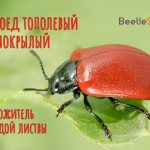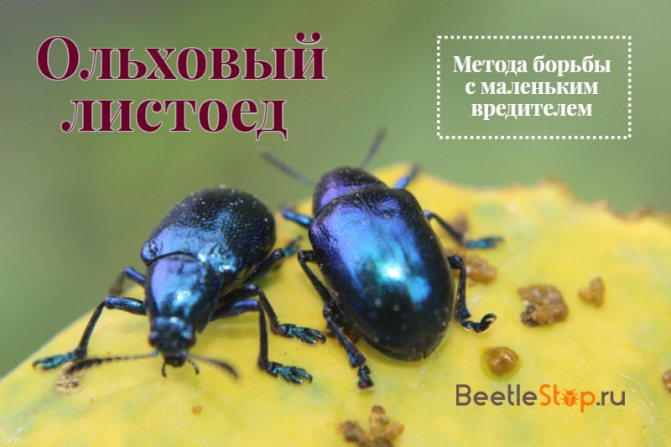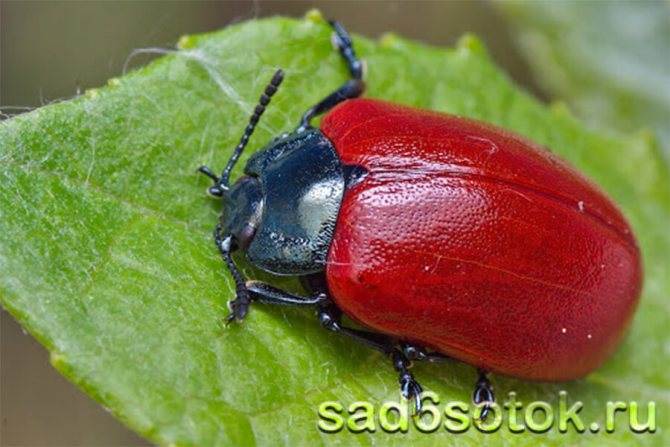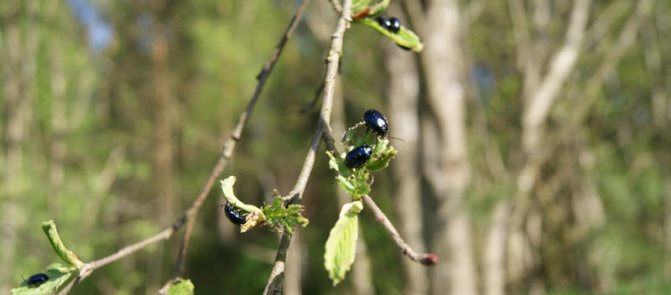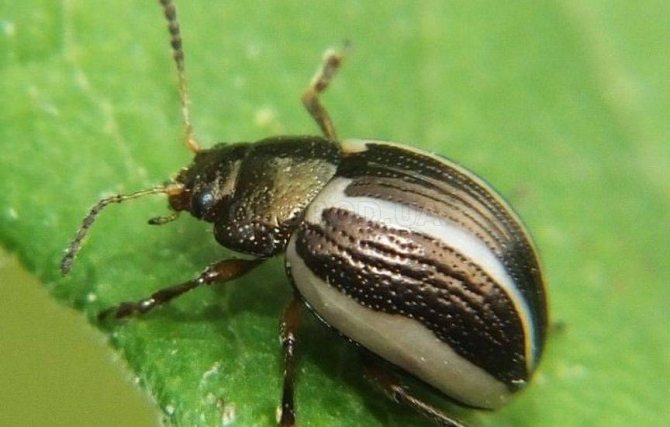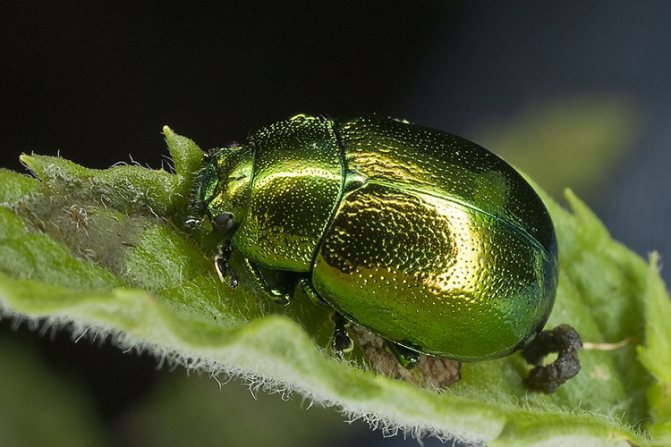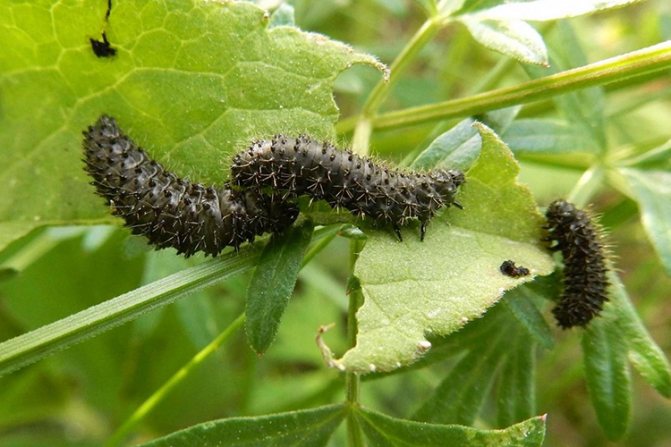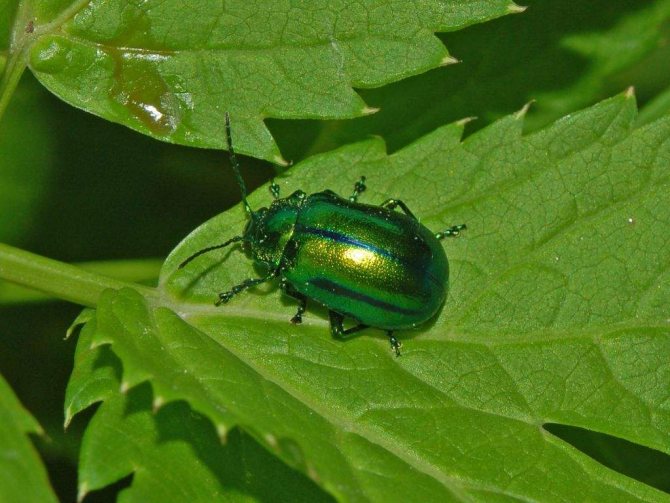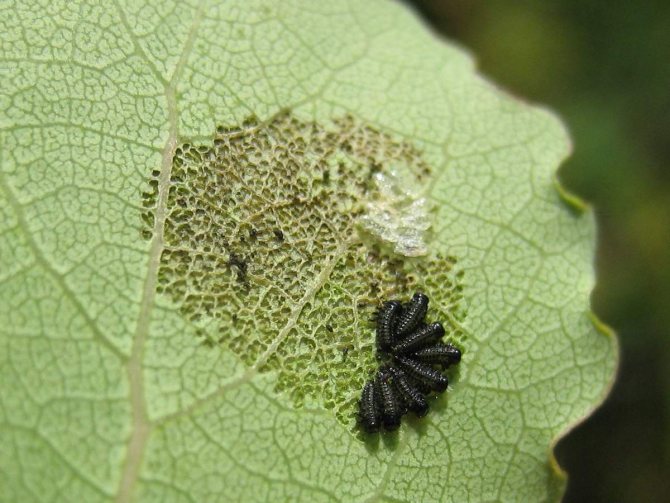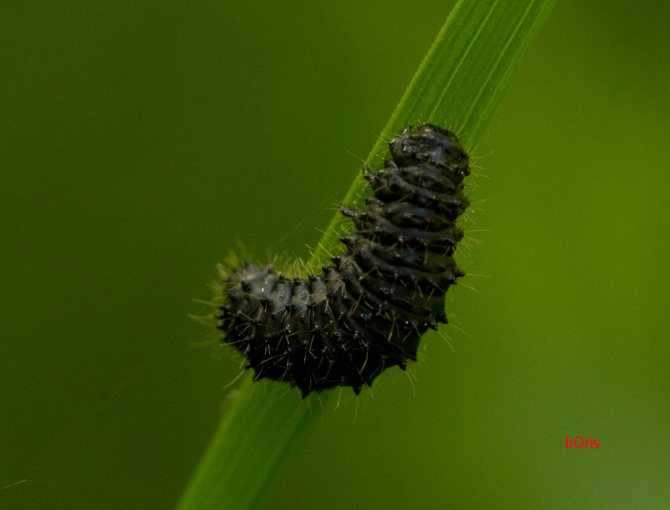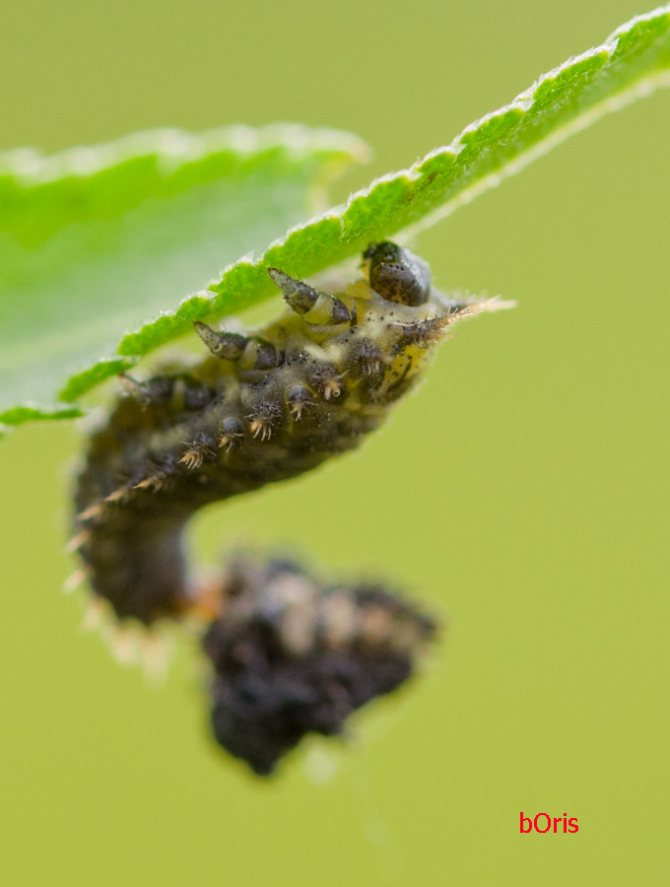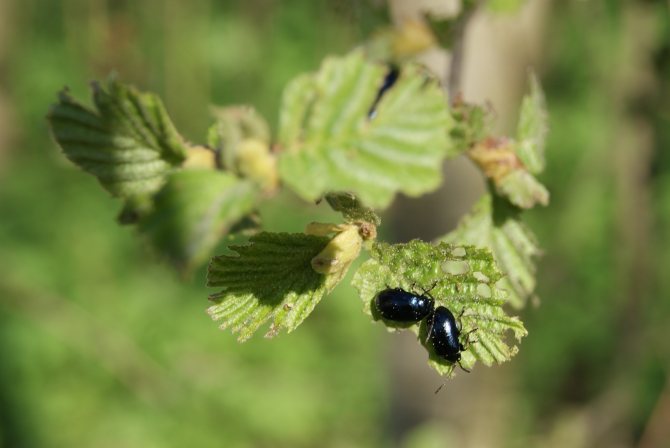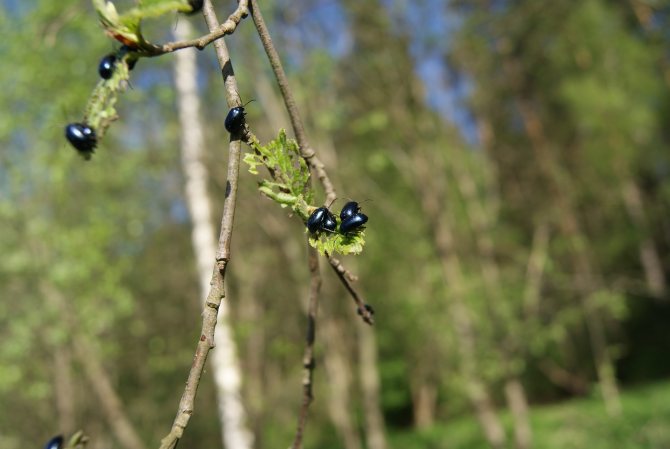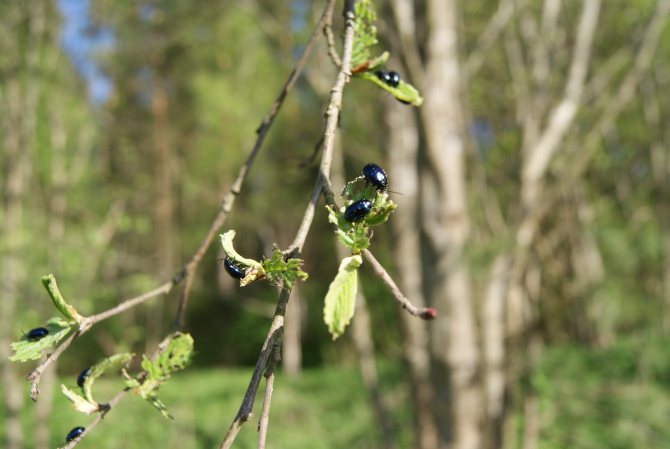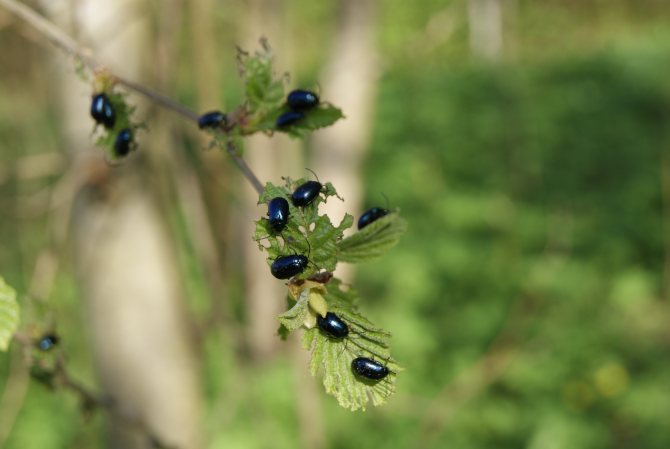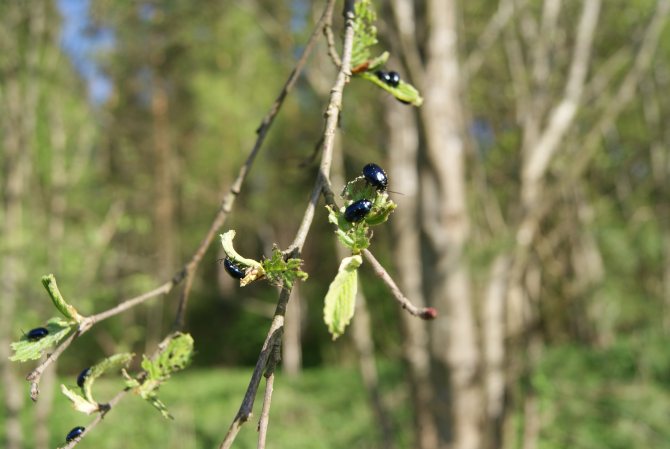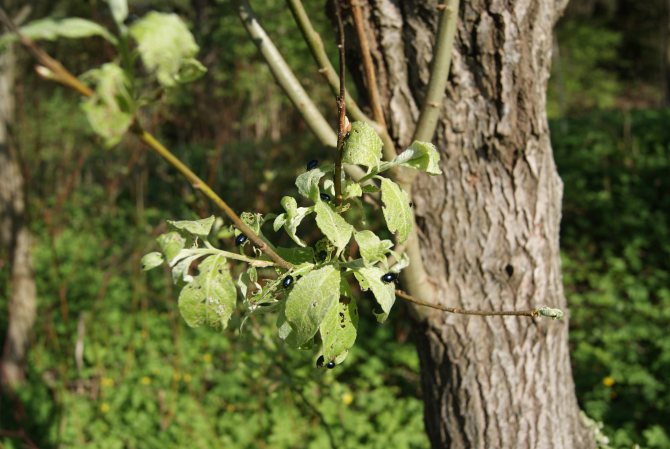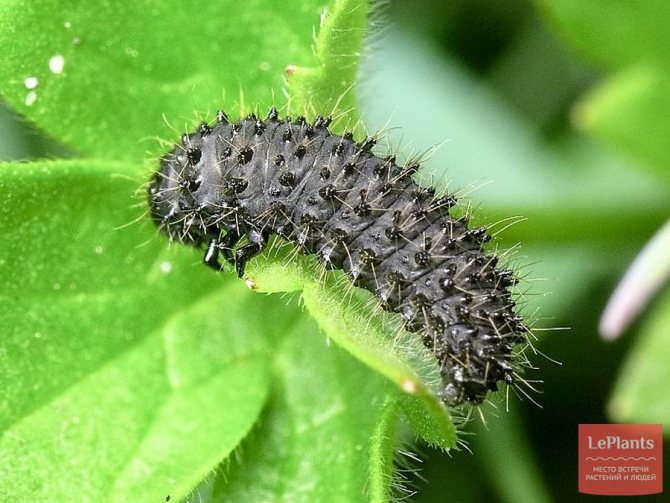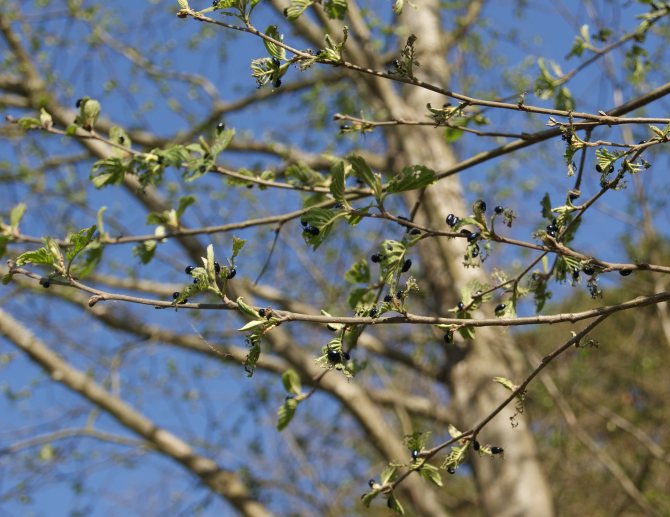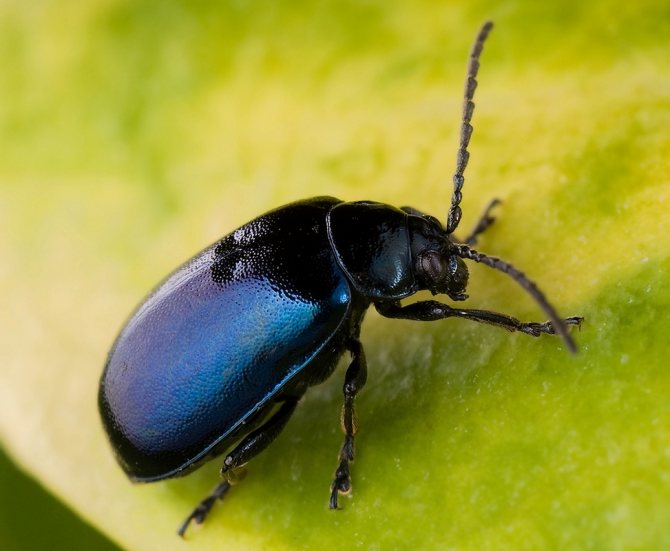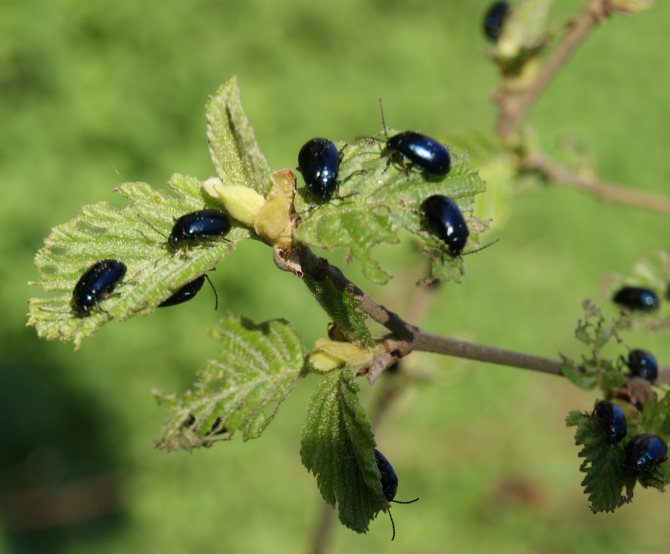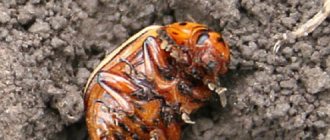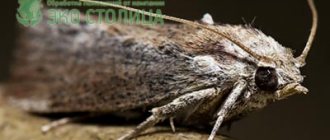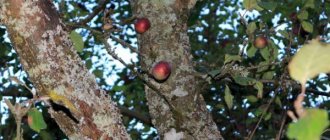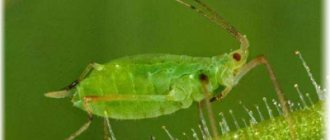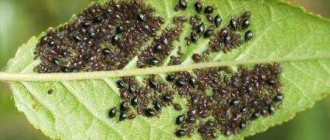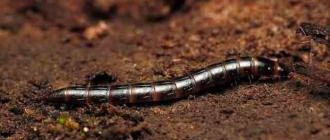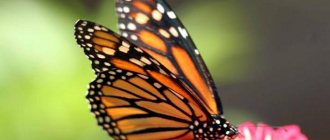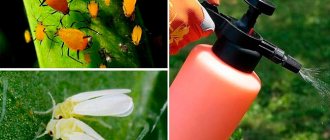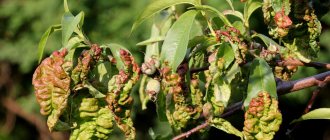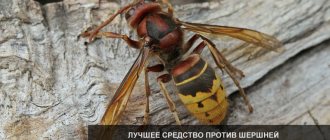The large family of herbivorous insects, leaf beetles (Chrysomelidae), numbers 35 thousand species. About 200 of them are pests of useful plants. On a vast territory from Europe to the Far East, the poplar leaf beetle is found. Poplar and willow serve as food plants of the insect. During the years of mass reproduction, beetles completely destroy the young foliage of protective plantations. In such cases, insecticides are used against poplar leaf beetles.
Pest appearance
General characteristics of insects are small body sizes - within 3-15 mm, oval or round body shape and bright color.
The body length of leaf beetles exceeds the width by 1.5–2 times. From above it is naked or covered with hairs or scales. The small head is retracted into the pronotum.
Adults have round eyes, a well-developed pair of transparent wings with convex elytra covered with dots. Antennae filiform or bead-like, directed forward. In most species, the antennae have 11 segments.
Legs short to moderately long with thickened hind femora. In case of danger, insects can hide antennae and legs. Females are larger than males.
Have larvae a straight or arcuate soft body covered with bristles and a sclerotized head. Depending on the species, the larvae may have 1–6 well-developed eyes. Hidden species do not have them. The body color is yellow, white, green, brown, black, dark blue.
Types of beetles
Strawberry leaf beetle
The beetle is yellow-brown in color. It grows in length up to 3-4 mm. Gray larvae are 2–3 mm larger than an adult insect. They appear on strawberry and strawberry beds during budding and damage plants throughout the summer.
Onion beetle
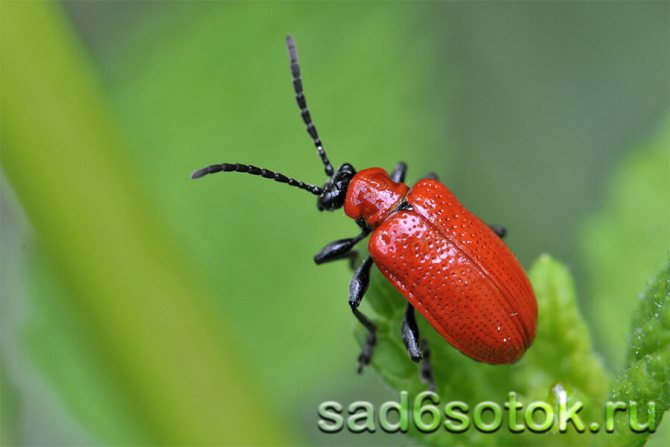
Onion beetle or onion rattle
The beetle is 6–7.5 mm in size, red-orange in color with a thick body and a large head. The larvae have a soft white body and a black head. Damages vegetable and ornamental crops.
Alder leaf beetle
The insect is 7 mm long, dark blue with a metallic sheen. The larvae are similar to a caterpillar, their body is black with a blue-green tint.
Viburnum leaf beetle
A beetle with an oval body 5–6 mm long, brown-yellow in color. The body is covered with dense short hairs.
The larvae are yellow-green with brown hairs on the upper side of the body and brown tubercles. The head and legs are darker than the rest. Older larvae reach 9–11 mm in length.
Ilm leaf beetle
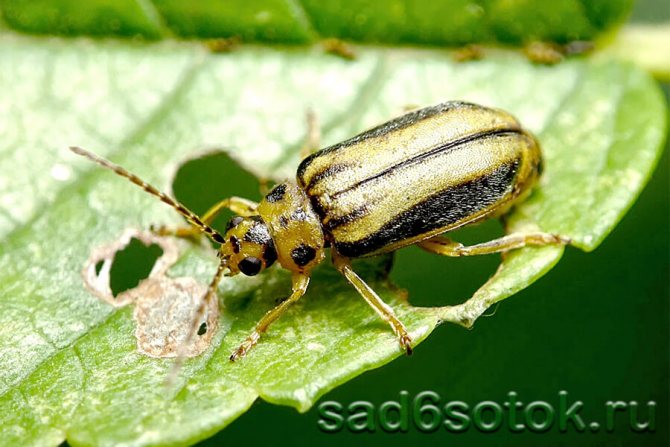

Beetle leaf beetle elm
Inhabits the steppe and forest-steppe zone in the European part of the country, in the south of Siberia. The insect has an oblong yellow-brown body 5–8 mm long. Damages elm plants of all ages.
Poplar leaf beetle
The beetle is 10–12 mm long with a black-blue body and bright red elytra. The larva has a thick gray-white or light green body with black dots on top, a black head and legs.
Strawberry leaf beetle
Strawberry leaf beetle – beetle, a malicious pest of strawberries. The larvae bring special harm to plants, gnawing the underside, the leaf becomes thinner and deformed. Under the influence of the sun, it actively dries up. On such bushes, the berries do not have time to develop to a varietal size; they also lose some of their taste, and in case of severe damage, the main part of the ovaries dies.
What does it look like
The beetle is small in size (3-4 mm), its color is yellow-brown, with a dark spot in the middle of the back.
The larva is yellow with a dark spot on the back, the head is dark brown.
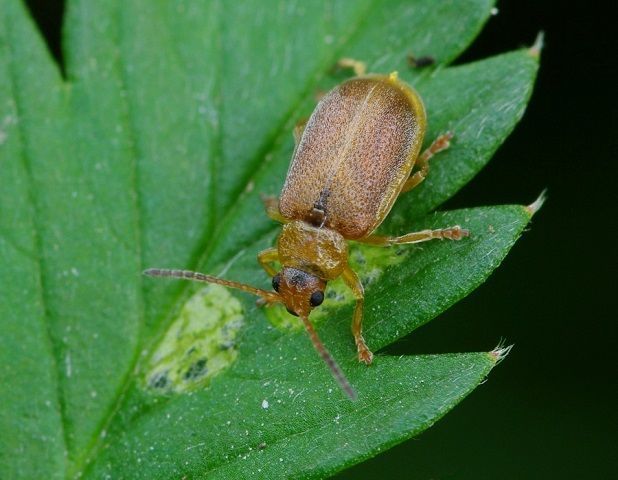

How do they reproduce
Usually, beetles hibernate under the remnants of vegetation in strawberry beds. In the spring, during the period of active growth of strawberries, beetles leave their wintering places and go to the strawberry bushes, eat away the pulp of the berries with winding tunnels.
The females lay eggs before the strawberry blossoms. They hide eggs on petioles, stems, sepals. Only ten days will pass, and larvae will appear, which will immediately find shelter for themselves - on the back of a strawberry leaf. There they will live, feed, gnawing out the lower tissue of the leaf, leaving the top intact.
After three to four weeks, the adult larvae descend from the plant to the ground, burrow to a depth of about 3 centimeters, and pupate there. At the end of strawberry fruiting, new beetles appear. Having lived a little on the leaves of strawberries, they hide for the winter.
How to fight
- First of all, get rid of weeds (especially meadowsweet and cinquefoil) around strawberry bushes, as the strawberry leaf beetle loves to live on these plants.
- For the treatment of bushes, only certain types of pesticides can be used, such as "Karate" (2 ml / 10 l), "Karbofos 10% (75 g / 10 l)
- At the end of fruiting, regularly loosen the soil under the bushes to kill the pupae of the pest.
- To compensate for the damage caused by beetles, it is recommended to use drugs that stimulate the growth and development of strawberry bushes.
- In early spring, in order to scare off beetles, pollinate the plants with tobacco dust (use this method with caution to avoid transferring the smell of tobacco to the berries).
Eggs and larvae
Most leaf beetles reproduce by laying eggs... Females in spring or early June place them on the underside of leaves or on the soil near plants. Each pile has an average of 5-30 eggs, and one the female lays 400-700 eggs in her life.
Bright yellow, yellow-gray, dark red eggs are clearly visible, therefore they often become prey for predatory insects: ladybirds, bedbugs. Females can protect eggs with special covers or cover them with excrement.
After 5–15 days, the first generation larvae emerge from the eggs. Dangerous pests live for 23-30 days... At first they live together and feed in a group. Then the grown individuals can move to other leaves or roots and feed individually.
Before turning into a bright beetle, the pest goes through the pupation stage... Within 10 days, organs of an adult insect are formed inside the pupa. Pupation occurs on leaves, in the lower part of the trunk, in cracks in the bark, or in the ground at a depth of 4–5 cm. Mass flight of young beetles occurs at the end of June.... The number of generations per year depends on the species and region. In temperate climates, 1-2 populations of leaf beetles appear.
The next generation of larvae hatches in mid-July, and beetles emerge at the end of August. In the winter, insects hide under fallen dry foliage and under lumps of earth.
Ways to fight
For the extermination of leaf beetles, agricultural methods can be used, or biological or chemical pesticides can be used. You can also control pests by increasing the population of their natural enemies.
Eggs and larvae of leaf beetles are included in the diet of ladybirds, bedbugs, ants, parasitic wasps and other predatory insects. Beneficial insects are attracted to the garden by flowering plants such as calendula, dill, cornflowers, dandelions, millennials, and other nectar-bearing flowers.
Frogs and lizards will gladly feast on larvae and adults. Thrushes, woodpeckers and other birds will also successfully cope with pests.Therefore, birds should be allowed to nest in the garden as they will be an excellent helper in the fight against parasites.
Agrotechnical
They include compliance with the technology of planting plants according to the characteristics of the landscape zone, measures for the mechanical elimination of pests, as well as further soil cultivation to prevent re-infection. The most effective ways to get rid of leaf beetles are:
- digging up the beds in the fall to destroy parasites that remained in the soil for the winter;
- loosening the soil between the beds in late May - early June;
- collecting beetles, as well as eggs and larvae by hand, placing them in a box or bottle with a sticky substance (the resulting "crop" will need to be burned in the future);
- cutting off branches and leaves that have been infected with parasites;
- elimination of plant residues from the beds;
- the use of covering material at the beginning of the growing season of plants;
- planting related crops at as large intervals as possible to prevent the spread of infection;
- planting crops a little ahead of schedule (this will enable the plant to grow stronger before the start of pest activity);
- compliance with the frequency of watering.
Biological
In the fight against leaf beetles, preparations created on the basis of natural biologically active chemical compounds that are synthesized by living organisms are effective.
One of the most popular drugs is Bitoxibacillin, an intestinal bacterial insecticide. It contains Bacillus thuringiensis var. Thuringiensis is a type of gram-positive bacteria that secretes endotoxins.
It can be successfully used against adults and larvae. However, the larvae of the first instars are most sensitive to the preparation; therefore, treatment should be started at the first mass appearance of parasites.
Another popular biologically active agent is the avermectin preparation Fitoverm. It contains the active ingredient Aversectin C, a biological insecticide, which is a mixture of four avermectins B1a, A1a, A2a, B2a - waste products of Streptomyces avermectilis fungi.
It has a contact-intestinal action. Effective against adults and larvae. It paralyzes pests so that they cannot move and are unable to damage the plant. The death of beetles occurs within 7-10 days.
Chemical
Among the chemicals that have shown the highest efficiency in eliminating leaf beetles are:
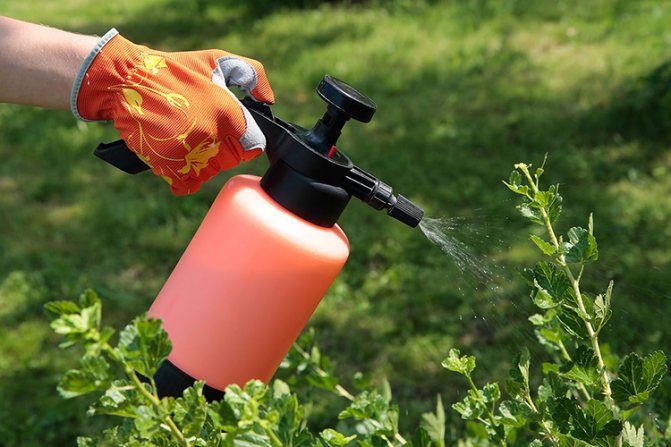

- Pyrethroids ("Fatrin", "Accord", "AltAlf", "Decis", etc.). These are synthetic analogues of natural pyrethrins found in Dalmatian chamomile flowers. Insecticides show good performance in the destruction of various types of pests of horticultural and horticultural crops. They have an intestinal-contact method of penetration, act quickly, remain effective in adverse conditions, and are resistant to washing off by rain.
- Organophosphorus compounds (Karbofos, Malaton, etc.). It is a poisonous substance of neuroparalytic action. Shows high insecticidal activity in the fight against a wide range of agricultural pests. Differs in the speed of action with low consumption of the drug. Low toxicity to humans. However, its use can negatively affect the health of mammals. In addition, it provokes the emergence of a resistant generation of parasites.
- Neonicotinoids ("Monsoon", "Gaucho", "Confidor"). Nerve poison. Moderately toxic to vertebrates, but fatal to insects. The drug is stable under adverse environmental conditions and retains its effectiveness. Since neonicotinoids are overly toxic to bees, some of their compounds are now banned in the EU.The safest substances from this group of insecticides are acetamiprid and thiacloprid, however, they can also negatively affect the bee population.
Signs of damage to plants and trees


Alder leaf beetle
Pests are mostly damage leaves and shoots of young plants... Less commonly, they feed on flowers, ovaries and fruits. Adult beetles eat small holes in the leaves, and the larvae gnaw out completely internal tissues, leaving only the veins intact..
Root damage is also common, mainly lateral roots and hairs. Inside the stem, the larvae gnaw through the passages, which disrupts the supply of nutrients and water.
As a result of the activity of leaf beetles leaves die off, trees and shrubs look bare.
Onion leaf beetle
The onion beetle is a pest of onions, garlic, and also affects other ornamental plants, the onion family. Beetles and its larvae bring harm.
What does it look like
Beetle - oblong, oval body shape; the color is orange-red, with many dots on the elytra, the abdomen is black. The limbs of the beetle are red with black markings.
The larva is grayish, on the sides there are markings of dots, the head and legs are black in color.
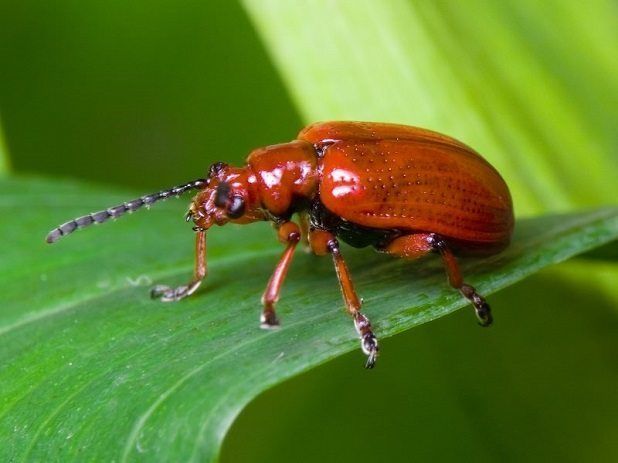

How do they reproduce
Beetles lay eggs from May to July. The emerging larvae are on the surface of the plants, feeding on the upper and lateral leaves. Further, through holes are gnawed, penetrating into the cavity of the leaf. After a few weeks, the matured larvae descend from the bulb to the ground and pupate there. Both adult beetles and pupae overwinter in the soil.
How to fight
Since it is impossible to use chemical preparations for processing plantings of onions and garlic, the following measures are used to protect against pests:
- Observe the crop rotation.
- Kill weeds regularly.
- Collect bugs manually.
- During the larval period, spray the plants with herbal infusions: bitter wormwood, high larkspur.
- All measures to combat the onion leaf beetle should be carried out in a comprehensive manner, not limited to just one.
Pest control methods
Chemical and biological products
Chemicals used during the period of mass appearance of larvae and release of adult insects... During flowering and 20-30 days before harvest, chemical treatment is prohibited.
Karbofos
Contact drug with a pungent odor. Destroys larvae and adult insects. The tool is used no more than 2 times per season. The consumption rate of the drug is 75 g per 10 liters of water.
Karate
This insecticide for leaf beetles is used once. The dosage of the drug is 2 ml per 10 liters of water.
Kemiphos
Preparation for early spring plant spraying. Trees and shrubs are sprayed 2 times in dry and calm weather at an air temperature of 12-25 ° C. The consumption rate of the product is 10 ml per 10 liters of water.
Phosbecid
A powerful insectoacaricide of systemic and intestinal action. To combat the pest, plants are treated in the morning or evening in calm weather. The solution is prepared at the rate of 5 ml of the product per 5 liters of water. The protective effect lasts 14 days.
Fitoverm
Multicomponent avermectin biological product. Not addictive to the pest. After treatment, insects lose their ability to move and feed and die after 6–7 days. The consumption of the remedy for leaf beetles is 1 ml per 1 liter of water. It will take 2-3 treatments at intervals of 20 days.
Bitoxibacillin
A biological product that successfully destroys the larvae of the pest. 40-100 g of the product is added to 10 liters of water and used 2 times with an interval of 6-7 days.
Traditional methods
The simple ways to fight are manual collection adult beetles and larvae, washing them off with a stream of water from a hose or soapy water from a watering can.
In dry weather, plants are sprayed with herbal infusions and decoctions. They are harmless to humans and animals. To enhance the action, 20-30 g of liquid or previously diluted laundry soap is added to the solutions before use.
- 0.5 kg crushed heads garlic pour 3 liters of water and put in a dark warm place to infuse for 5 days. For spraying, 60 g of the concentrate is mixed with 10 liters of water. According to another recipe, 50-100 g of cloves are ground and added to 10 liters of water. The well-mixed solution is immediately ready for use.
- 100 g dry mustard pour 10 liters of hot water and leave for 2 days. For spraying, the infusion is mixed with water in a 1: 1 ratio. The precipitate should not be agitated and get into the solution.
- Small plants and shrubs are powdered wood ashto protect the leaves from damage.
The benefits and harms of leaf beetles
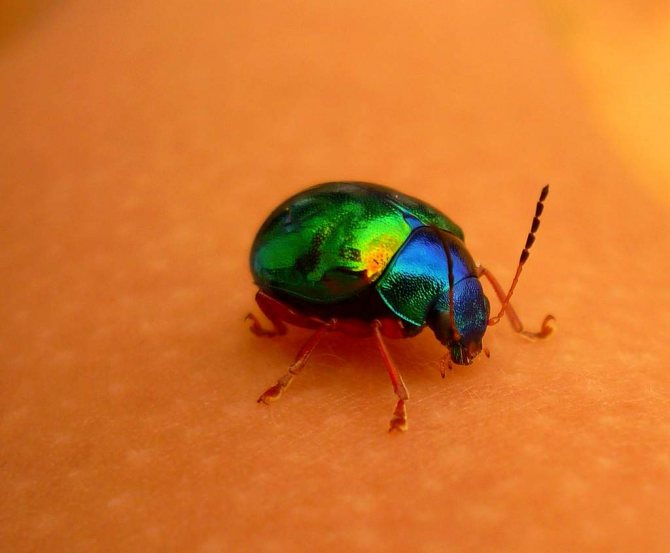

There are many types of leaf beetles.
There are economically important species among leaf beetles. For example, some leaf beetles are used to control weeds. This species is the ragweed striped beetle, which allows you to control the growth of the ragweed weed. These leaf beetles were brought to our country from Canada and the States.
Some herbal leaf beetles are used to control the weed St. John's wort, which causes significant damage to agriculture. These leaf beetles were specially brought to Australia, North America and New Zealand to fight St. John's wort.
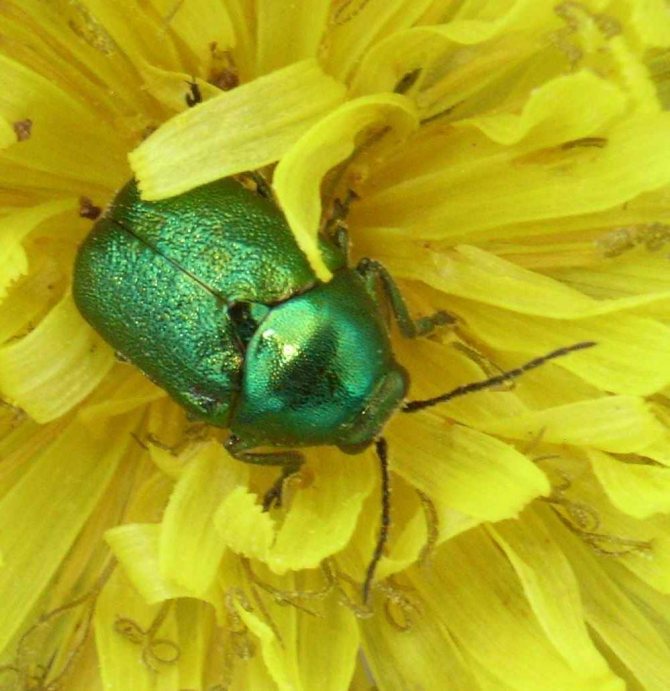

Some leaf beetles are used to control weeds.
One of the fierce crop pests, mostly potatoes, is the Colorado potato beetle, which also damages tomatoes, peppers and melon pears.
Poplar and blue willow leaf beetles damage ornamental plants used in landscaping, such as poplars and willows.
Mint flea
Mint flea beetles, also known as jumping beetles, are one of the main pests of peppermint.
Numerous populations of these insects are found in the North Caucasian, West Siberian, Central Chernozem and Volga regions.
Adult beetles are light brown, reaching a length of 1.8 centimeters. Winter is spent delving into plant debris at the edges of forests and plantings. And with the onset of spring heat, they migrate to gardens and plantations of fodder plants.
Pests can be detected by characteristic damage to the leaves. Fleas gnaw out the soft tissues of the leaf plates from above, without biting through the lower epidermis. The holes are round or irregular.
These beetles are especially dangerous for immature young plants. An increase in the beetle population is observed in dry and hot weather, when mint suffers from a lack of moisture and is especially sensitive to insect attacks.
Severe damage leads to stunted growth and death of the stems.
Females place the eggs in the ground. Young larvae feed on small mint roots without causing significant harm to it. Pupae are formed in the soil. Reborn beetles climb to the surface and actively eat mint leaves.
One generation of insects develops per year.
To kill insects, mint is treated with a solution during the period of leaf regrowth.
Mint mite
Mint mites are considered the most dangerous mint pests. Most often found in the southern regions of Europe and Russia.
These small insects, up to 0.5 centimeters long, feed on the sap of plant tops. When feeding, a special secret is isolated, leading to the destruction of the chloroplast and the death of the shoots.
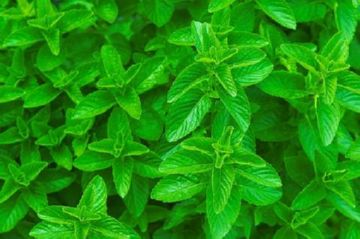

On mint beds, mites appear in mid-May. Females are capable of laying 10 eggs per day. For a year, ten or more generations of pests develop.
For wintering in the ground, adult females leave, which wake up with the onset of stable spring heat and very quickly begin to lay eggs.
This pest spreads easily along with the planting material. To kill mites, mint seedlings are treated with acaricides (Metaphos, Phosphamide).
To prevent infection, the beds are dug up in the fall and all plant residues are necessarily burned. After two years, the mint must be transplanted to a new location.
The old plot is dug up and set aside for other crops for three years (then the mint can be returned to its original planting site).

